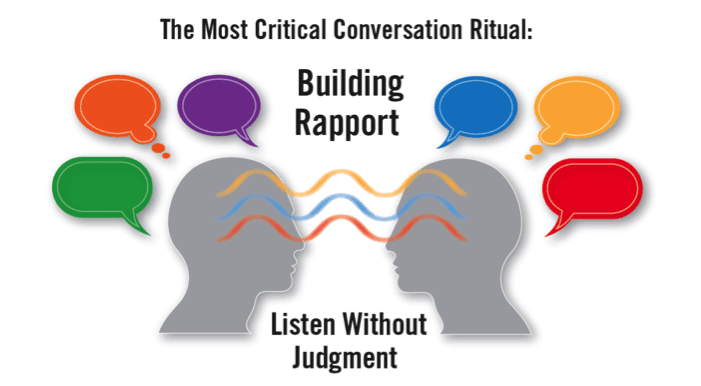How To Use Active And Perceptive Listening To Close The Deal
Lou Carlozo
Imagine for a moment that this column isn’t being read by you: It’s being read to you. The chances are that you would tune out the material, or might not retain the information in a meaningful way. An active process becomes a passive one, and instead of absorbing the information, you may feel like you’re being talked at by someone who has an agenda.
Yet how many salespeople practice a variation on this very theme, either reading pitches straight from a script—or, assuming they get past their introduction with a client, begin to recite chapter and verse the virtues of their product?
We get it. People in sales want to sell. Badly. But there’s another side to the selling process that’s a lot more important than talking.
It’s listening.
Judith Glaser, the Chairman of The Creating WE Institute and CEO of Benchmark Communications, describes the normal listening continuum this way:
Hmmm. That’s quite the opposite of what you should really shoot for, the “80-20 rule” where you listen to 80 percent of the time and talk 20 percent of the time. But Glaser says it’s more involved than that simple ratio. What you really want in the end, Glaser says, is this:

“The most vital skill set is to ‘listen to connect’—not to judge or reject,” Glaser says. “When we listen to connect the other person feels heard and appreciated for the perspective they bring.”
Experts agree: Listening is active listening, and it’s also perceptive listening. And it means a different approach to the sales process. It’s one where you show engagement and ask questions to get to the heart of a person’s concerns.
Active Listening: Learn What Truly Matters to Your Customer
Richard Ruff, the co-founder of Sales Horizons in Phoenix, notes that there is research that says after listening to someone, a person will only remember half of what was said. And after eight hours, you only remember half of that.
“The research is clear: In successful calls, the buyer is talking more than the seller,” Ruff says. “Listening has received less of an emphasis. But it’s a big deal because when you listen, you can genuinely understand what matters to the customer—so that when you talk about the product, you are positioning your product in terms of what matters to them. Selling value is what it’s about—and selling value is still the key to success in selling.”
He adds: “You can listen four to five times faster than someone can talk, so use the time to evaluate what is being said and take notes. You have to take time to make sure that you’ve not only understood what they’ve said, but vice versa. If you want to be a great salesperson you have to take 100 percent responsibility for both of those. That’s the “100 Percent Rule”—salespeople must take 100 percent of the responsibility for making sure the customer understands them.”
Perceptive Listening: Read Between the Lines
Then there is perceptive listening, “when you hear and interpret the words as they’re said, but also consider what the person isn’t saying, what they might really be thinking, and how they are acting as they speak,” says author John Jantsch in his upcoming book “Duct Tape Selling: Think Like a Marketer—Sell Like a Superstar.”
Perceptive listening, he notes, “is by far the most complex of the four because it requires you to be totally focused, completely mindful and, well, perceptive, of the conversation, both spoken and unspoken.”
Yes, but how does one become a better active and perceptive listener? Drawing from our experts, we uncovered three important steps you’ll want to take to improve your listening-to-connect skills, so that you can ultimately create strong rapport and close the sale.
Step 1: Admit It. You’re a Lousy Listener
“The first step is for someone to recognize that they’re likely not in the habit of listening at all—few of us are,” says Tracy Benson, founder and CEO of business consultancy On the Same Page. “I recommend trying this experiment next time they’re in an important conversation: Casually ask someone who’s talking to you to pause for a moment after a few minutes so that you can confirm that you understand what’s being said. Then repeat back to them what you heard them say.”
That’s the beginning of active listening: to repeat things back to a person in a way that shows you’ve understood what was just communicated to you. It isn’t parroting, and comes much closer to what Stephen Covey called empathic listening: not only being able to repeat back the content of the information, but also the emotional thrust behind it.
Step 2: Make It Personal By Asking Clarifying Questions
“The key is to make it personal and make it count,” Benson says. “Ask clarifying questions and deliver on any promises to follow-up with information you may not have at the ready.”
Ruff describes it this way: “These are very specific behaviors can be learned. You summarize: ‘Can we just pause for a minute? You mentioned there were things that were important to you. Let me make sure that I understood them.’ That way you can make sure you and the customer have a shared vision of what the priorities are. You not only have to listen, the customer has to know that you’ve listened.”
Step 3: Keep an Ear Out for Pain Points or Opportunities to Help
“Ask questions to understand the problem, pain, or opportunity,” agrees Greg Bustin, a Master Chair for Vistage International, the world’s largest CEO membership organization. “Your questions shouldn’t come necessarily from a checklist—although effective salespeople write down their best questions once they’ve found a zinger—but rather from listening to understand the other person’s pain or opportunity and how you can help.”
How can you help someone today? You may think you know, but you may never know for sure until you ask what Glaser calls “‘Questions for Which You Have No Answers.’ This means that you are listening to learn from the other person.” She adds that “our brain responds to listening, connecting and being appreciated very differently than when we are asking questions to guide people to our point of view. In .07 seconds we can ‘read another’s intentions – and know if we want to open up or close down.”
Wow. That’s a lot faster than most smartphones or electronic gizmos. So listen up: Take a moment. Put the gadgets down. And help the other person open up.
Get sales tips and strategies delivered straight to your inbox.
Yesware will help you generate more sales right from your inbox. Try our Outlook add-on or Gmail Chrome extension for free, forever!
Related Articles
Melissa Williams
Melissa Williams
Casey O'Connor
Sales, deal management, and communication tips for your inbox

